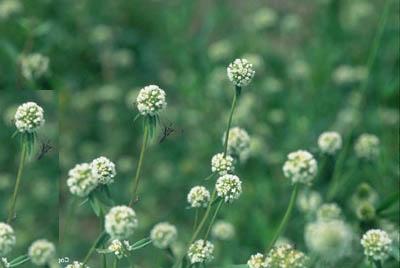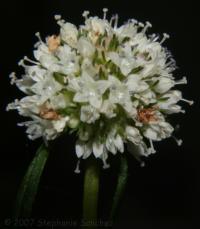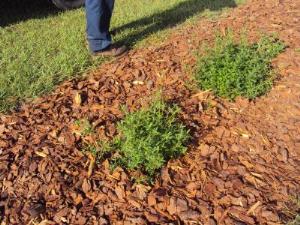
Southern Larraflower
- Eco-Cricket Plant
food source for mole cricket hunter Larra wasp
Turf-Tec No longer offers this plant..... The southern Larra flower is now produced by:
 Dennis
Gretton
Dennis
Gretton 
D&D Growers
11036 TUTEN LOOP
LITHIA, FL 33547-2688
813-716-5038
Dennis can also ship the plants in Florida and attends many plant sales and events around the state.
Larra bicolor wasps, also called mole cricket hunters, were introduced to Florida and now have been seen in most counties in Florida.
The southern larraflower Plant or Eco-Cricket Plant is now being grown and sold through Turf-Tec International as a food source for adult mole cricket hunter Larra wasp. (Plants are available in Florida only). These plants provide a sugar source (nectar) so the wasps have enough energy to find and lay eggs on mole cricket adults, eventually killing the mole cricket.
About the wasps:
Larra wasps are solitary wasps, have no communal nests to guard, and are not "aggressive." All of them are parasitoids, and all attack only mole crickets. Two species of Larra wasps now call Florida home. Larra analis is a native species, widely distributed in the eastern USA, at least as far north as Pennsylvania and as far west as Kansas, in places where its host, the native mole cricket Neocurtilla hexadactyla is distributed. Larra bicolor is native to South America, was introduced to Florida and attacks only pest mole crickets. University of Florida / IFAS researchers imported Larra bicolor alive from Puerto Rico in 1981 and from Bolivia in 1988; these adult wasps were released in Florida at sites where the southern larraflower or Eco-Cricket Plant had been planted as a nectar source to support their existence. By 2008, Larra bicolor had been detected in most Florida counties.
In Florida, adult wasps (both species) have been seen as early as May and as late as December, with a longer activity period in southern Florida. They are seen most abundantly in the autumn (September to November), usually feeding at flowers. When they are not feeding at flowers, wasps are seldom seen.
How does the wasp kill mole crickets?
The female wasps will fly out at least 250 yards from the plants to hunt for adult mole crickets. The female Larra wasps enter mole cricket tunnels and chase out the mole cricket to the surface. They lay an egg on each mole cricket they catch. After a few days, the egg hatches into a wasp grub that feeds on the mole cricket and kills it. Then the wasp grub makes a cocoon in the ground and after six weeks, an adult Larra wasp emerges and begins the cycle all over again, for free!
All you need to do is provide a nectar source by planting the southern larraflower or Eco-Cricket Plant and mother nature will do the rest.
 About the Southern Larraflower or Eco-Cricket Plant
About the Southern Larraflower or Eco-Cricket Plant
The southern larraflower or Eco-Cricket Plant grows like a weed, it is a perennial and is native to the West Indies, Central and South America. They are non-toxic, non invasive and drought tolerant. The plants grow best in full sun and do not like too much water. They can be planted in a bed to minimize area used. They grow from 18 inches to 40 inches tall and grow from the spring till the first hard frost. The next spring the plants will re-grow from its root mass. The southern larraflower or Eco-Cricket Plant provides the perfect balance of nectar and shallow flowers, where the wasps can obtain nectar.
Acknowledgement to Dr. J. Howard Frank Professor - Entomology at UF/IFAS for his work studying this plant and wasp relationship
LARRA-FLOWER - Southern Larraflower or Eco-Cricket Plant (Available in Florida only)
Home / Search Site / Catalog
/ Online Ordering / Map of site / Newsletter
/ On line consult / Contact us
History / Web Designs / Request Catalog / Search Engines
Copyright 2014